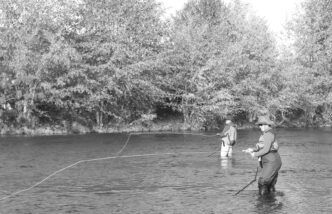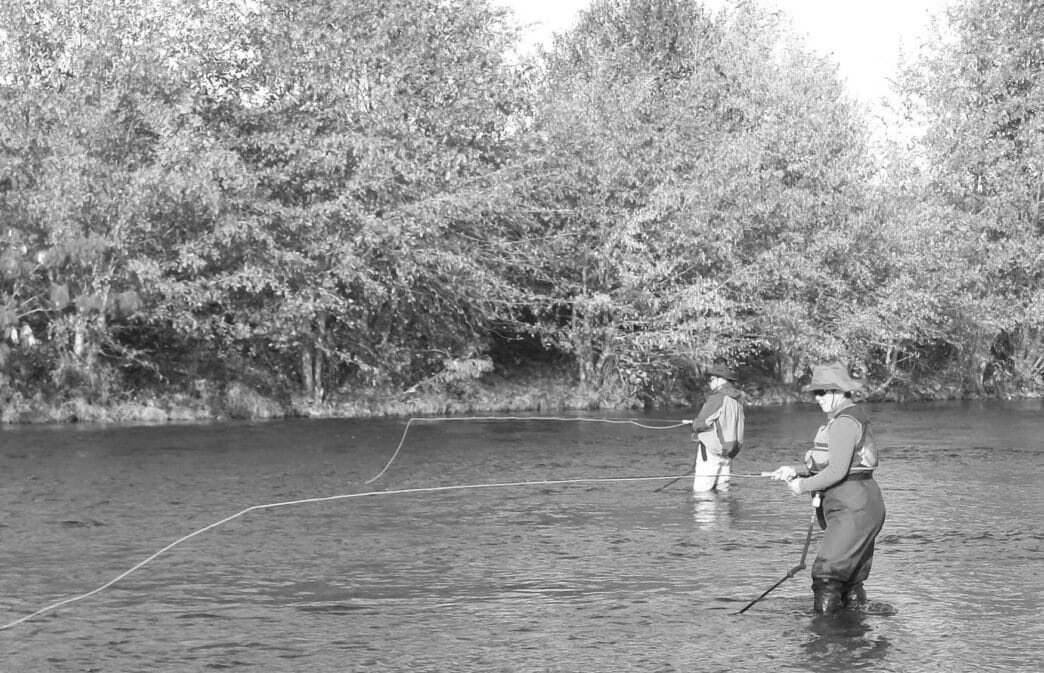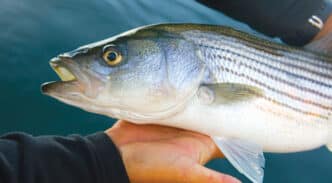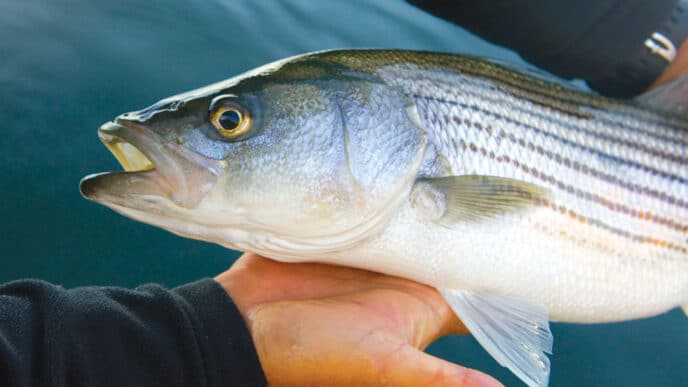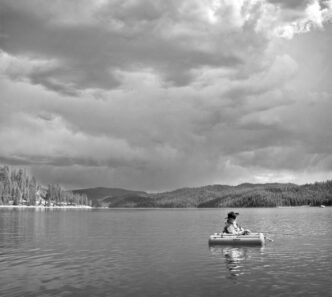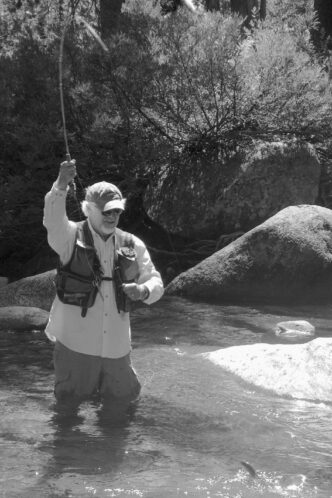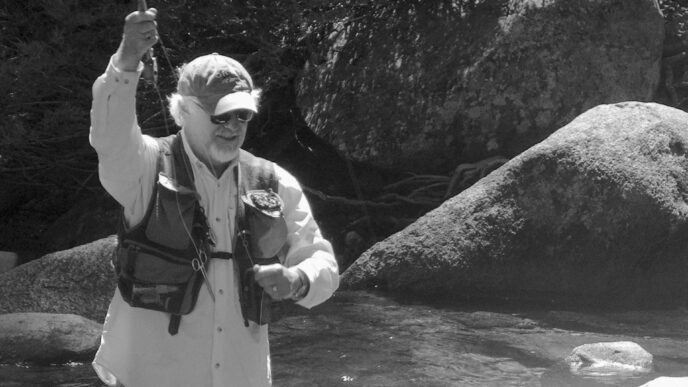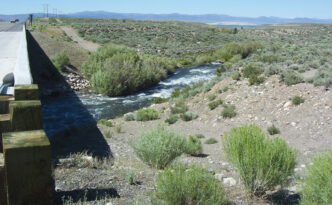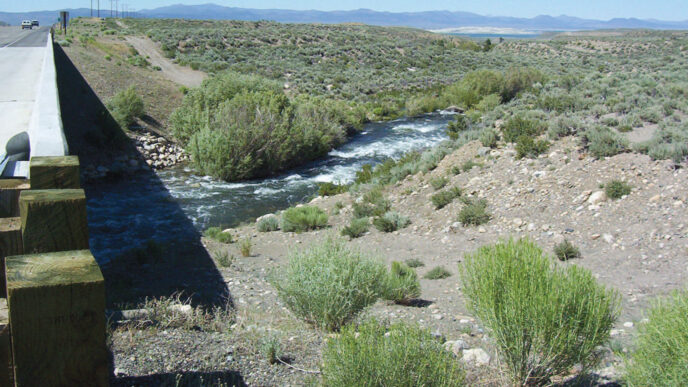The feather river has seen many changes, some good, some bad. Some were brought by fortune seekers during the Gold Rush, others by the hydroelectric power plants that produce power today. Once full of gold, this river still holds chrome and silver — not ore, to be sure, but steelhead that continue to return to it each year. Angling for these fish can be very frustrating at times, but it can also reward you with a different kind of metal than shone in the dreams of the Forty-Niners, the kind that swims through anglers’ reveries.
An Overview of the Feather
Lake Oroville captures the waters of the North, Middle, and South Forks of the Feather River. This impoundment, along with its associated hydroelectric and water-management facilities, the Thermalito Diversion Pool, Forebay, and Afterbay, are part of the massive irrigation and hydroelectric infrastructure of the California Water Project. When Oroville Dam was finished in the late 1960s, migrating salmon and steelhead were stopped cold in their tracks, no longer able to move up into the upper-river spawning grounds of the North, Middle, and South Forks. As a consequence, today anadromous fish are to be found in the Feather River only below Oroville Dam.
In an effort to mitigate this loss, the Feather River Hatchery was opened in 1967 to spawn and rear both salmon and steelhead in a state-of-the art hatchery. The hatchery is capable of receiving thousands of salmon and steelhead and can produce millions of eggs, which in turn produce millions of fingerlings. The fish that do not enter the hatchery spawn in the river. The system thus produces both hatchery-reared steelhead and “wild” steelhead. Both wild and hatchery fish form a fishery that at times can be quite good. (Note: hatchery steelhead have had their adipose fins clipped. Anglers may keep one of these fish each day. All wild steelhead — fish with unclipped adipose fins — must be released.)
The winter steelhead run starts in the late summer and continues until December. The spring-run fish start to trickle into the system in early January and continue through April. Adult fish, both hatchery and wild, can weigh from three to six pounds, with some fish reaching eight pounds.
The Feather River below Oroville Dam can be broken down into two different river sections — the low-flow section and the high-flow section. The low-flow section is a tailwater fishery that begins after the Thermalito Diversion Pool has shunted water from the base of the dam into the Thermalito Forebay and Afterbay complex to generate power. The flows from that point down to the next section are fairly consistent at around 600 cubic feet per second. The water is cold and contains fish all year.
The high-flow section starts at the Thermalito Afterbay outlet that returns the shunted water to the river and runs all the way down to the confluence with the Sacramento River. The high-flow section does not have consistent water flows. At times, the flows are three to four times that of the low-flow section. The water in the high-flow section also is warmer, due to the water sitting in the shallow Forebay and Afterbay. Although the high-flow section does hold fish in the cooler months, in what follows, we’ll be concerned solely with the low-flow section, in particular, the section below the Highway 162 bridge. That’s where the action is.
The Low-Flow Section Riffles
The low-flow section has multiple riffles that hold fish consistently and is open year-round. This section is accessible by foot from the Oroville Wildlife Area and Riverbend Park. It is also accessible by drift boat, and some riffles are best fished in that way, rather than on foot. If you are a confident oarsman, you will not find the river difficult at all. But afoot or afloat, every riffle can hold fish. If you fish an area with no results, move. Find the fish!
The Bridge Riffle, right below the Highway 162 bridge, is a great place to start. It has salmon redds, shelves, and a long run to fish. The fish hold in this riffle consistently. You can access this riffle from the new Riverbend Park by driving south to the 162 bridge on the dirt road before the main entrance of the park. You can also access this riffle via the Oroville Wildlife Area at the Outhouse Riffle by wading upstream.
The Outhouse Riffle is just below the Bridge Riffle. It has salmon redds on the top end of the riffle. The water flows fast and slides down a shallow shelf into a deeper pool. The Outhouse Riffle is a good place to dead drift nymphs down the long seam or to pull out a switch rod or Spey rod and swing alven imitations just after the first of the year. The Outhouse Riffle is easily accessible from the Oroville Wildlife Area.
Matthew’s Riffle downstream from the Outhouse Riffle is a deep, classic steelhead riffle. This riffle is accessible from the Oroville Wildlife Area. This riffle has it all — a shallow top section with salmon redds, a long seam, and good water depth. The riffle runs from shallow to deep, with a couple of deep holes in the main current. It’s a great riffle to dead drift or high stick nymphs. This riffle is also good for swinging flies deep.
Robinson’s Riffle is the next riffle downriver. The riffle has one of the largest shelves in the low-flow section. The water on the top end of the riffle is only inches deep. Once it falls off the shelf, the water deepens to 20 feet. The riffle can be fished by dead drifting nymphs down the seam of the current or by swinging flies on sink tips. The takes when swinging flies off the shelf can be jolting. This riffle is accessible from the Oroville Wildlife Area.
White Gate Riffle is directly downstream from Robinson’s. This riffle is full of salmon redds and long runs. It can also hold fish all year. The top end is easily fished with both standard rods and switch rods. Swinging flies off the numerous shelves into the redds below can be productive. Fish every little spot on this riffle. Fish can be holding anywhere from two feet of water underneath the willows to wide-open water behind rocks. This riffle is easy to access from the Oroville Wildlife Area. To be successful in White Gate, you must wade into position, but the steelhead can become very sensitive to anglers wading in this riffle. High sticking and dead drifting nymphs are productive techniques for fly fishers.
Steep Riffle is the next in line. It is accessible from the White Gate Riffle by walking downstream. The fish hold in the fast, well-oxygenated water of the current at the top end of the riffle. The fish also hold on the shelf. Fishing this riffle on foot can be done, but it is very difficult. The water is deep and has a quick current and a very abrupt shelf. High sticking and dead drifting flies are productive tactics. It’s a great riffle to fish from a drift boat.
Osprey Riffle is next. This riffle is similar to Steep Riffle, but larger. The water that splits the island is very fishable. The drop-off at the shelf is vertical, and the water is fast. This riffle is commonly fished from a drift boat. Anglers who want to walk in and wade must park their vehicles on the main road of the Oroville Wildlife Area and walk at least a quarter of a mile to the river.
Eye Riffle is the last of the riffles in the low-flow section. This riffle is best reached by foot from the Pacific Heights Road via the south entrance of the Oroville Wildlife Area. This riffle has two large pools with a run down the middle. Salmon redds can be found on the south side of the river, and some are very deep. Dead drifting nymphs is often a productive technique.
A note of caution: Steelhead will often hold below salmon (and steelhead) redds, feeding on eggs as they are disgorged by the females or that become dislodged during the process of creating a redd. If the water is shallow, you can sometimes see the redds, which are roughly circular depressions in the river bottom, and they’re easily felt while wading. To protect the salmon and steelhead fisheries, please stay out of all redds while fishing.

Equipment and Flies
The river is easily fished with either standard rods or double-handed rods, whichever the angler prefers. Single-handed rods for Feather River steelhead should range from 6-weights to 8-weights, in lengths of 9 to 10 feet. Even a standard trout rod works quite well. The best switch or a Spey rods are 6-weights or 7-weights, 12 to 13 feet in length. Make sure your reel is of steelhead caliber, with a reliable, low startup-inertia drag and at least 100 yards of backing. The fly line should not only match the rod, but should have outstanding mending ability. Fly patterns can range from standard nymphs to Spey flies. Some of the most productive flies are egg patterns in shades of champagne and orange, a size 14 Cluster Egg in the “Oregon Cheese” color (which also works great for the sucker spawn in the spring), Trina’s PT, size 14 to 16, Morrish’s Dirty Bird, size 14, an olive Bird’s Nest, size 14, Gray’s Fire Worm, size 14, and Gray’s Alven, size 6. For switch rods and Spey rods a Willie Nelson, size 6, and Morrish’s Dirty Bird, size 8, work well.
Presentations
Both dead drifting nymphs or egg patterns under an indicator and swinging flies are productive on the Feather River. The dead-drift indicator technique is great for working seams and high sticking the shelves and redds. You must wade to the correct position to make this presentation. Face the river with the seam you want to fish directly in front of you, staying at least one-rod length away from the seam. Cast upstream at a 45-degree angle. Make two upriver mends or a stack mend immediately. Once the indicator passes you, mend upriver or stack mend to feed line out to allow the fly to dead drift down the seam. The drift can be as long as you wish. Many drifts are between 30 to 50 feet. You can repeat the cast, make a cast to the next seam, or simply take a couple of steps downriver and cast again. The dead-drift presentation can cover water quickly and thoroughly with little effort. Both standard rods and switch rods work well for dead-drift presentations. High sticking with the dead-drift setup is also possible and very effective.
Swinging flies on the Feather River is often done with either a switch rod or a Spey rod. Some of the riffles, such as the Outhouse Riffle and Matthew’s Riffle, are better suited to double-handed casting. When fishing a switch rod, a standard steelhead-taper line, uplined at least two weight sizes, will usually load the rod correctly and is also versatile. You can dead drift flies with this setup, or you can quickly slide on a poly leader and fish flies on either shallow or deep swings. When fishing a standard Spey rod, a short Scandi line tends to work very well. The line can be changed quickly to match whatever situation you need to address.
If You Go…
Access points for steelhead anglers fishing the Feather River on foot are well-marked. To access the river from Riverbend Park, take the Montgomery Street exit off Highway 70 and head west. Riverbend Park will be directly in front of you. Turn south on the dirt road until your reach the Highway 162 bridge. To access the north side of the Oroville Wildlife Area, take the Highway 162 exit from Highway 70 — Oro Dam Boulevard —and head west. The Oroville Wildlife Area road is approximately a quarter of a mile west. There is a brown sign that marks the entrance to the Oroville Wildlife Area. Turn south on the dirt road.
The western access point for the Oroville Wildlife Area is located off of Larkin Road. From Highway 70, take the Highway 162–Oro Dam Boulevard exit and head west. Go west on Highway 162 approximately one and a half miles to the Larkin Road intersection on the south side of Highway 162, just before the Oroville Municipal Airport. Turn south on Larkin Road. The Oroville Wildlife Area road is on the left, approximately three miles south. There is a brown sign to mark the road. The road will give you access to the lower riffles.
The southern access point is located off Highway 70 on Ophir Road. Ophir Road is south of the city of Oroville and is well-marked. From Highway 70, turn west on Ophir Road, then immediately turn south on Pacific Heights Road. The Oroville Wildlife Area access point is approximately two miles down Pacific Heights Road. There are two white gates on the right, with a brown sign that marks the Oroville Wildlife Area.
Anglers who want to fish the Feather River by drift boat can put in at the Riverbend Park boat launch. The new launch there is well lighted in the early morning hours. The park is open from first light to sunset, so plan your drift accordingly. The drift is approximately four miles, and the take-out for the low-flow section is located just above the Afterbay outlet at the Larkin Road access point. This launch is gravel and quite steep, so a four-wheel-drive vehicle is recommended.
In the past, the area has seen problems with cars getting broken into and equipment stolen. Moving the roads and gates has helped deal with this issue. Patrols of the Oroville Wildlife Area by law enforcement also have increased greatly. Still, always use common sense and don’t tempt thieves or make their job easy.
With regard to fishing regulations, the river is closed to angling all year from the Fish Barrier Dam to the Table Mountain bicycle bridge in Oroville. It is open to angling from January 1 through July 15 from the bicycle bridge to the Highway 70 bridge; only barbless hooks may be used on this stretch. From the Highway 70 bridge to the mouth, the river is open to angling all year long. The entire stretch from the Fish Barrier Dam to the mouth is closed to salmon fishing. Only one hatchery trout or steelhead may be kept per day.
Lance Gray



